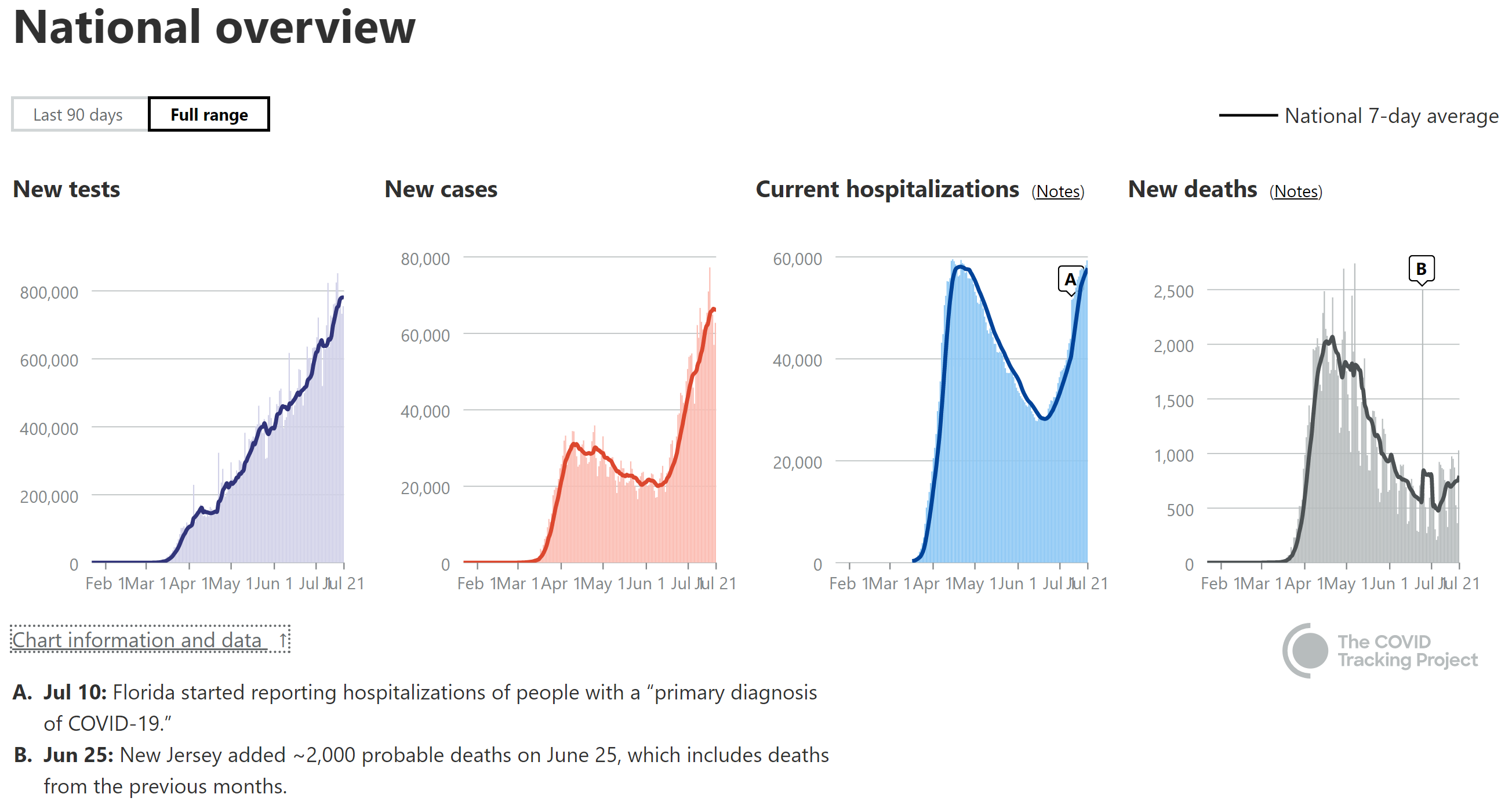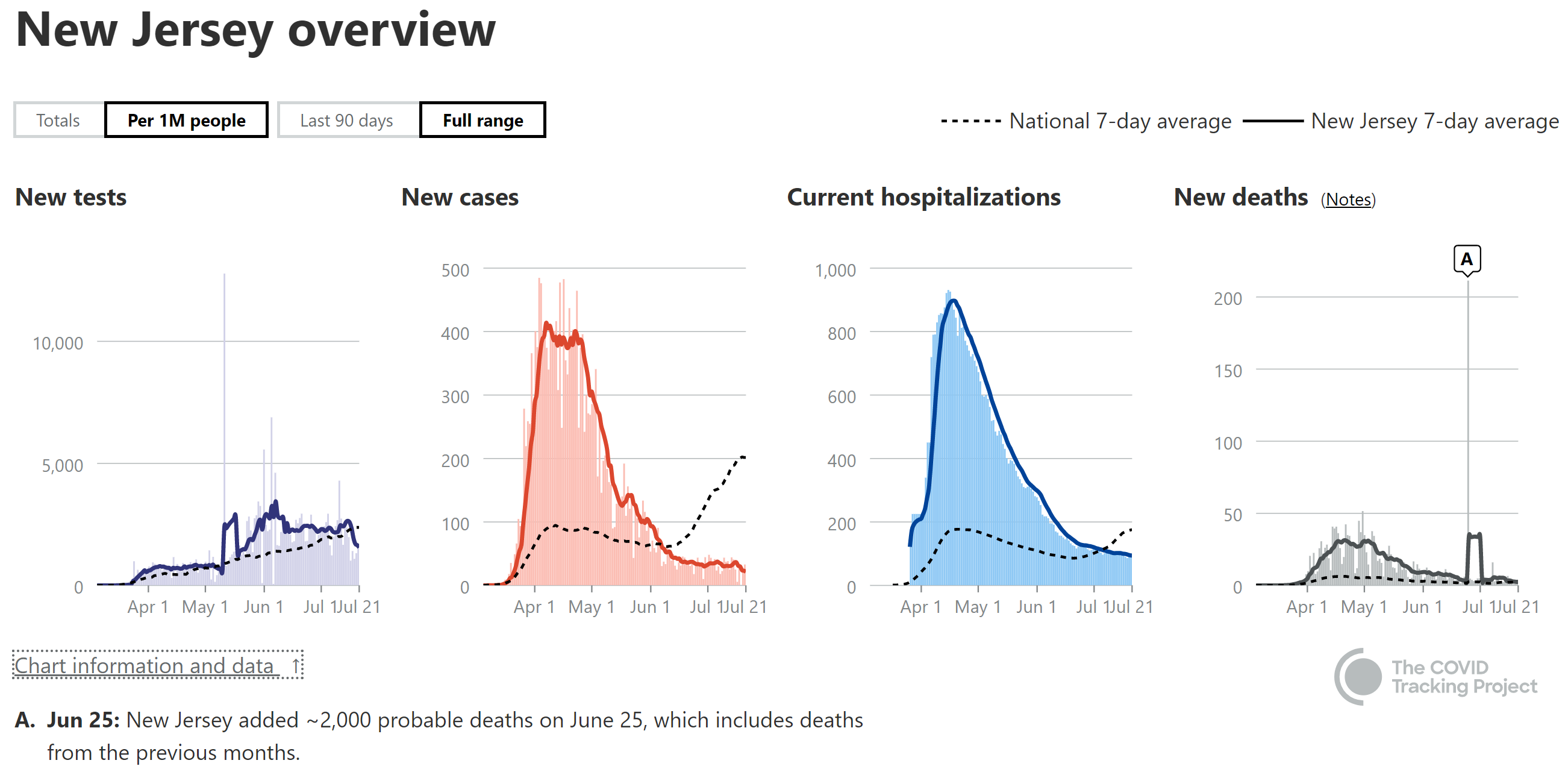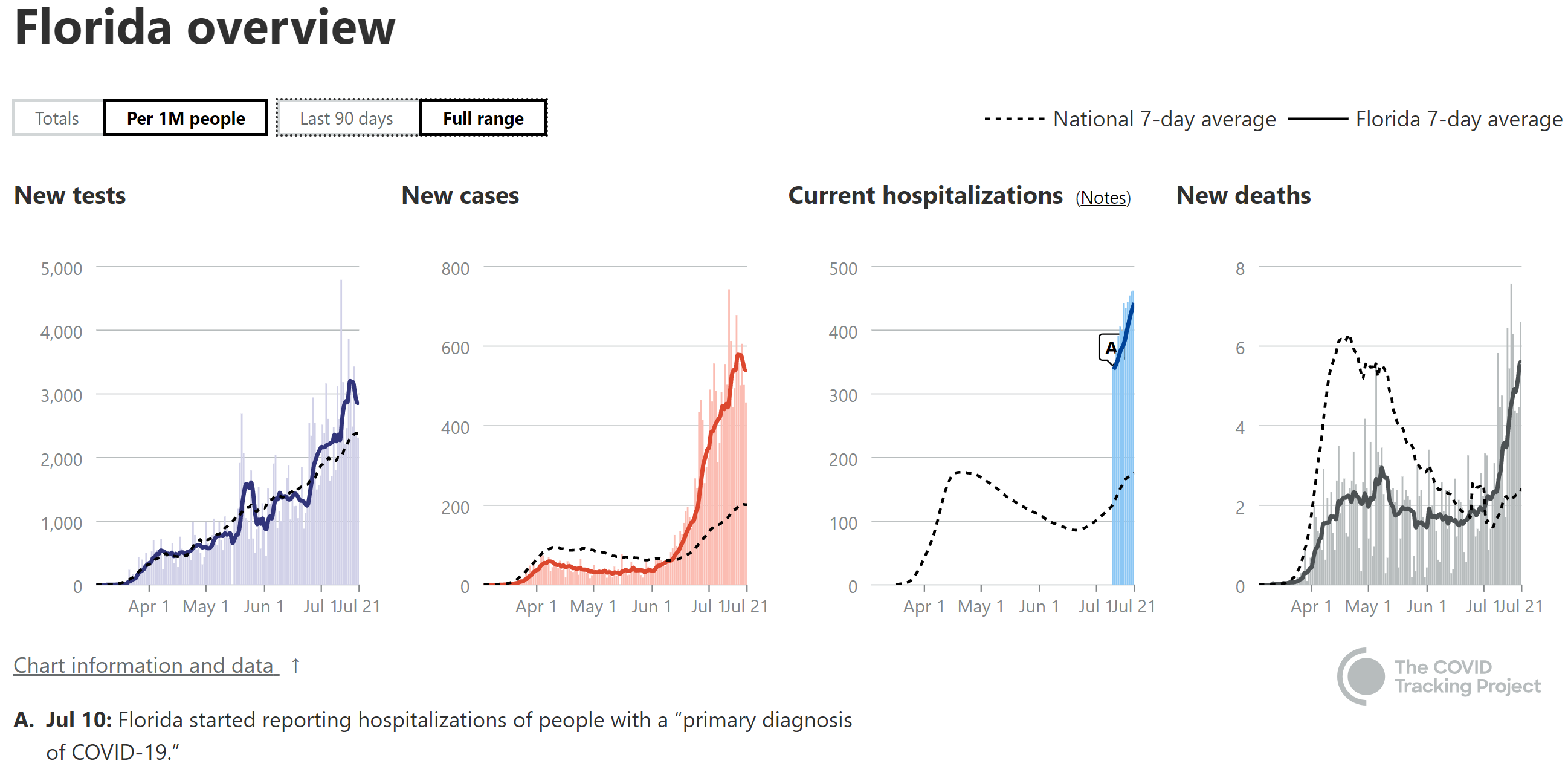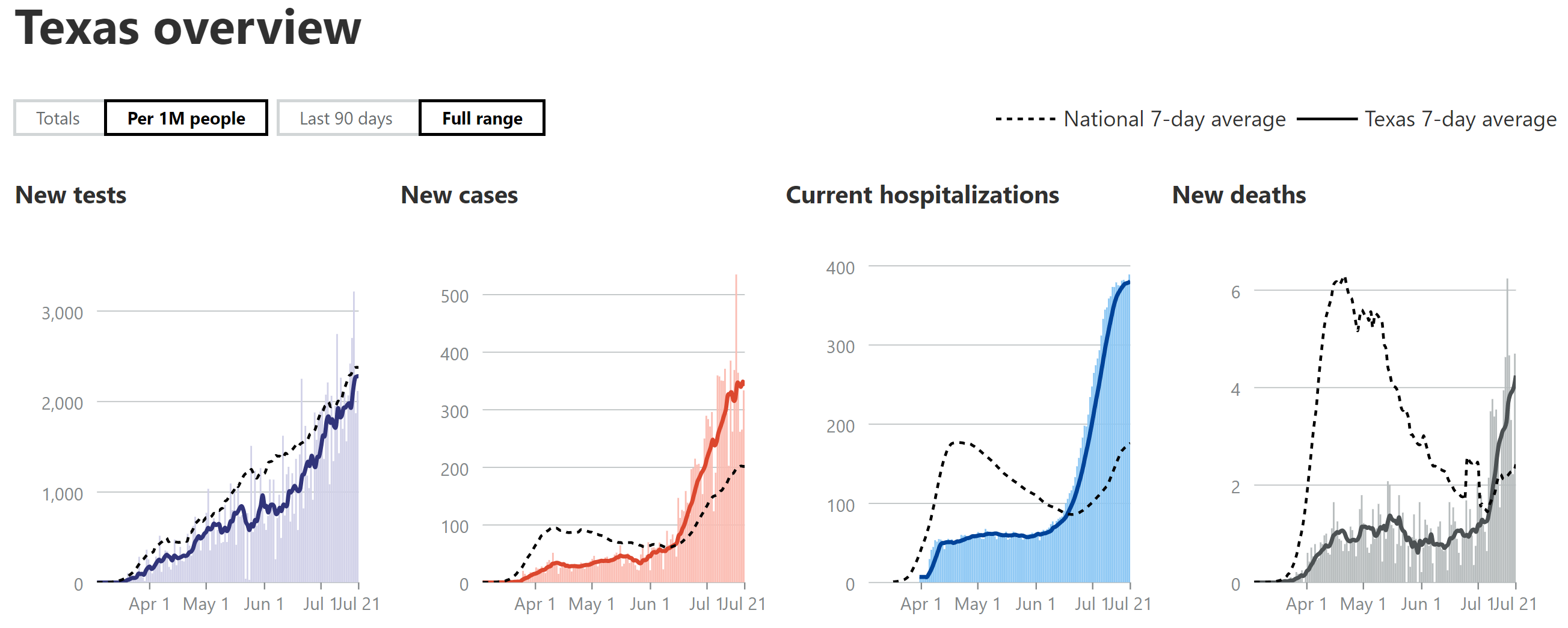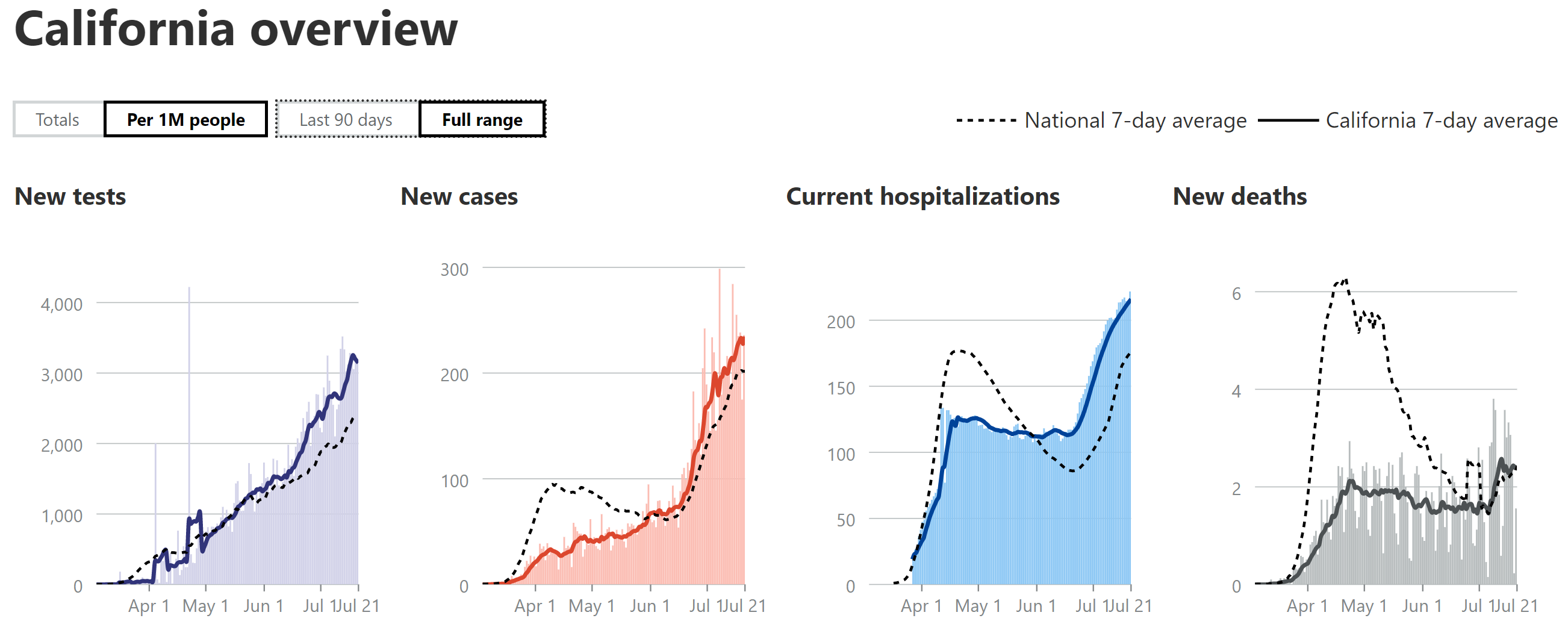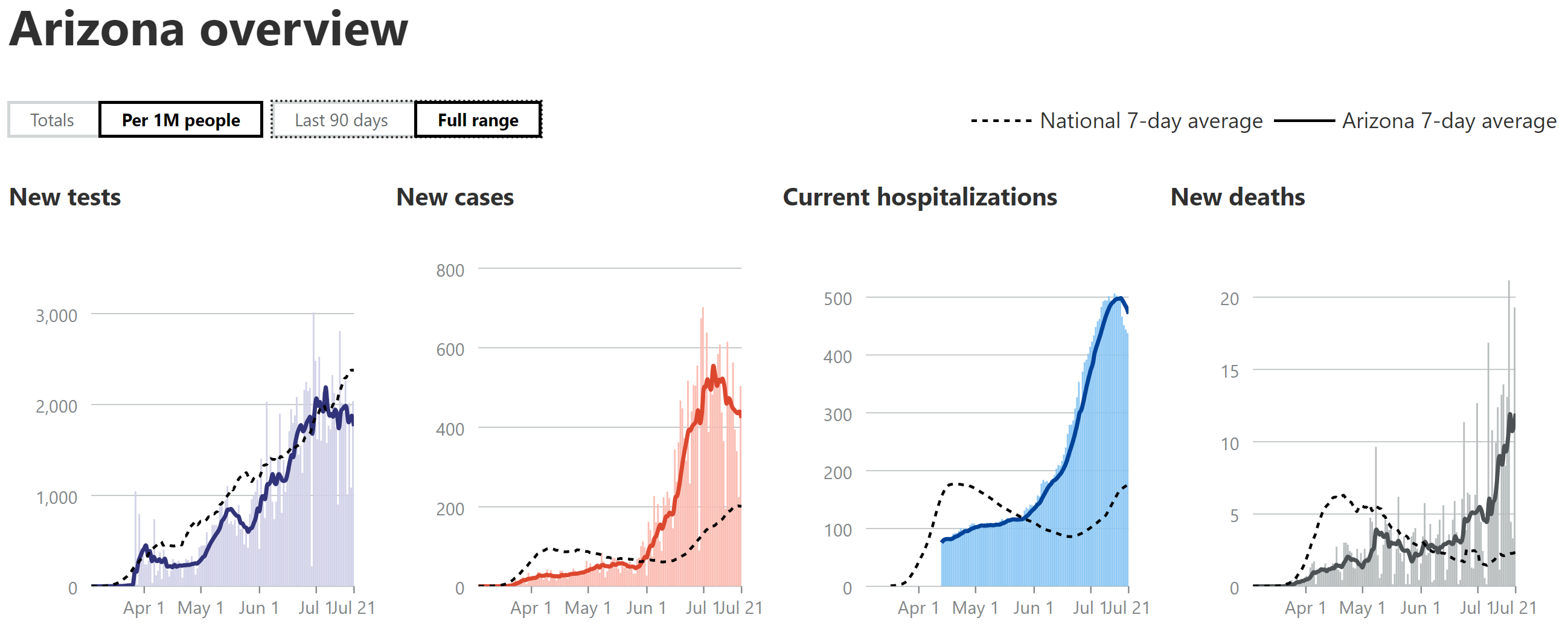Time to revisit this, since I said there would be a 2-4 week lag from cases starting to rise significantly to deaths rising significantly in response. With those significant rises starting around 6/15 for TX/FL/CA (with CA maybe 2-3 days behind TX/FL; also the start was maybe 6/1 in AZ and 6/22 in GA), that meant deaths were likely to start rising somewhere between 6/29 and 7/13 in those three states and looking at the graphs below, we certainly started to see death rates rise by around 7/7-7/8 and they were clearly rising by 7/13. The huge question, obviously, is how high will they go? Keep in mind that the following comparisons are being made on what we all know are likely flawed datasets, but it's the only data we have and my main focus is on death rates, assuming we should at least be able to count those reasonably well. I used the COVID Tracking Project graphics (JHU data), as they offer cases/hospitalizations/deaths and tests per capita on a 7-day moving average on one page per state, so the state comparisons are at least apples to apples. I wish they offered the multiple state comparisons on one chart for deaths that they offer for cases.
https://covidtracking.com/data
My guess has been per capita deaths will be moderately to significantly lower than what we saw in the first wave in the NE US, especially in NY/NJ, so I'm including NJ for comparison purposes (the graphics below also show the US death rates on the same graphic as each state and these are all 7-day moving averages). My first guesstimate was about 1/2-2/3 the death rate, per capita of NJ, given the much younger average infected patient age in these S/W states, the lesser disease severity seen when tested positive (since far more people are being tested per day, per capita now), and, the combination of improved medical procedures and pharmaceutical treatments (like remdesivir, dexamethasone, tocilizumab, and especially convalescent plasma). I then adjusted that guess to 1/3-2/3 the NJ per capita rate when it started looking like hospitalization rates would likely be maybe 30-40% lower in AZ vs. NJ's (as AZ was ahead of the other states). CA/TX/FL are still ramping up in hospitalization rates, but are well behind the hosp/case ratio we saw in NJ.
Looking at the graphics below, NJ had a peak of just over 30 deaths per 1MM people, so 1/3-2/3 of that would roughly be 10-20 deaths/1MM. Right now, we see FL closing in on 4 and Texas around 3.4, while CA is just below 3, but TX/CA have both had recent peaks on multiple days around 4 deaths/1MM and FL has been up to 6. These numbers are still well below 30 deaths/1MM and below my 10-20 guesstimate, but they're rising and the rise is looking at least moderately steep right now, plus AZ is already almost at 10 deaths/1MM, with several days peaking over that level, so unfortunately, it looks like at least 10 deaths/1MM is in range. Let's hope CA/TX/FL don't even reach the 10 deaths per 1MM level and that we can figure out exactly why, i.e., how much of the drop is due to which variable (age, severity, procedures, or treatments).
And let's also hope that the greatly increased case levels, which are now close to or above (in FL and AZ) NJ's per capita case rate (which we should note was likely significantly greater than reported, as full testing wasn't in place back then at the peak) don't lead to major outbreaks among the elderly in these states. If that happens and the average infected age rises significantly, NJ-level death rates per capita start to become possible.
Summary:
- Nationally, cases are peaking at ~2X vs. the first wave, while hospitalizations haven't quite peaked, but will likely be a bit more than half of what they were in the first wave (per capita). Deaths are up 60% from their early July low and climbing steadily, but are only 35-40% of the April peak.
- Cases have peaked (AZ) or are likely peaking (FL/TX/CA) at levels at or above NJ's peak case levels per 1MM people (per capita basis), except for CA, which is well below NJ's peak.
- AZ's hospitalizations peaked at ~55% of NJ's (per 1MM) and FL/TX will likely peak in that region (they haven't peaked yet, though), while CA will likely peak well below that, at maybe 25% of NJ's peak; these reductions vs. NJ are likely due to the much younger age of those infected in this wave.
- We still don't know where death peaks will end up but my guesstimate has been 1/3-2/3 of the peaks of NY/NJ, partly due to the younger age of those infected (as above) and partly due to improved treatments and procedures. AZ is already at 35-40% of NJ's peak and deaths there might be starting to peak, but not in the other states yet. FL/TX seem likely to reach 1/3 of NJ's peak level, but CA will likely not be more than 15% of NJ's peak.
Details - Cases
Updating this post a week later and will try to do so weekly for awhile, as weekly as likely infrequent enough to not be fooled by 1-2 day deviations that aren't that relevant (like the usual weekend dips), but frequent enough to see changes occurring. Let's look at cases first, starting with the national picture, where total cases seem to be just reaching a peak around 65-67K cases per day on a 7-day moving average (all the data are on that basis in the charts below), which is about twice what the peak in the first wave was (around 31-32K cases/day).
The "good" news is Arizona has likely peaked in cases and started to decline a bit, although it's too early to call it a real decline, yet, IMO, while Florida, Texas, and California are all nearing or possibly at their peaks (I think, judging by the shape of the 7-day curves). Many other states could be discussed, but these seemed relevant, as FL/TX/CA are the three most populous states and they're peaking and AZ peaked a bit earlier and has a similar population as NJ, which I'm including as a comparison from the worst of the first wave. It should be noted that AZ peaked about 20% above NJ's peak, FL is peaking around 40% above NJ's peak, TX is near NJ's peak, and CA is only at about 60% of NJ's peak (I'm also using per capita data for all the graphs, so they're "apples to apples" comparisons).
Details - Hospitalizations
With regard to hospitalizations, on a national level, hospitalizations are still growing, but not as fast as they were (they only lag cases by a week or so) and they're looking to probably be only a bit above what they were in the first wave, despite there likely being twice as many cases. This was expected a few weeks ago, when it became clear that there was a much younger average age of those infected in most states in this current wave (vs. wave 1) and the hospitalization rates in AZ (which had a 1-2 week earlier outbreak than FL/TX/CA) were tracking at about half the rate of NJ's. Note that if COVID were as deadly as it was in the first wave (it's thought to be) one would expect eventual death peaks to mirror relative hospitalization rates, i.e., if a state peaks at 50% of NJ's peak hospitalization rate, one would expect deaths to be around 50%, also (assuming no improved treatments/procedures).
Looking at states, AZ has now peaked at about 55% of NJ's hospitalization rate, i.e., about 500 per 1MM vs. NJ's 900 per 1MM (all per capita). FL hasn't peaked yet and is at about half of NJ's peak rate, while TX might be starting to peak at just below half of NJ's rate (too early to call yet), and CA is close to peaking and is only at about 25% of NJ's peak. It's not surprising that CA's case and hospitalization numbers (and likely deaths) are not as bad as the other three states in this comparison, as CA reopened later and after having achieved better reopening metrics, plus CA made masking mandatory on 6/18, just as cases were starting to rise significantly, while the other three states didn't start issuing mask requirements until later and they're not nearly as strong as California's.
Details - Deaths
With respect to deaths, on a national level, they've jumped about 60% from the low in early July and are now up around 830/day on a 7-day moving average, which is about 35-40% of the death rate at its peak in April. Note that the 4 states (FL/TX/CA/AZ) I've been discussing account for about half of that death toll per day, which also means that there are many other states with less people, many of which are also spiking in cases, hospitalizations and deaths. We still don't know where death peaks for these states will end up (or total deaths, since that will also depend on whether a peak is sharp or a plateau and long decline, like NY/NJ had), but my guesstimate has been 1/3-2/3 of the peaks of NY/NJ, partly due to the younger age of those infected (as above) and partly due to improved pharmaceutical treatments (such as remdesivir, dexamethasone, tocilimuzab and convalescent plasma) and improved medical procedures.
With regard to specific states, AZ is already at 35-40% of NJ's peak and deaths there might be starting to peak, although it's too early to make that call yet - they've had several individual spikes that were at 50-60% of NJ's peak, so I think that 50-60% is possible to reach with the 7-day moving average. FL/TX/CA have not peaked yet and FL/TX, in particular appear to still be climbing rapidly, with FL currently at about 20% of NJ's peak and TX currently at almost 15% of NJ's peak, so FL/TX seem likely to reach at least 1/3 of NJ's peak level (largely based on comparison to AZ) and maybe more. However, CA likely won't reach more than 15% of the NY/NJ peak given the lower hospitalization rates.
Keep in mind that all of these are educated guesses and a big wild card is assuming cases don't go way up amongst the elderly from here on out - they already are increasing in FL and if that continues and also occurs in the other states, these states could easily reach or exceed the upper end of my estimated range of 2/3 the level of NJ's deaths. Hope people find these to be informative - please let me know if any obvious errors (hard to keep all the #'s straight, lol).
https://covidtracking.com/data#chart-annotations








